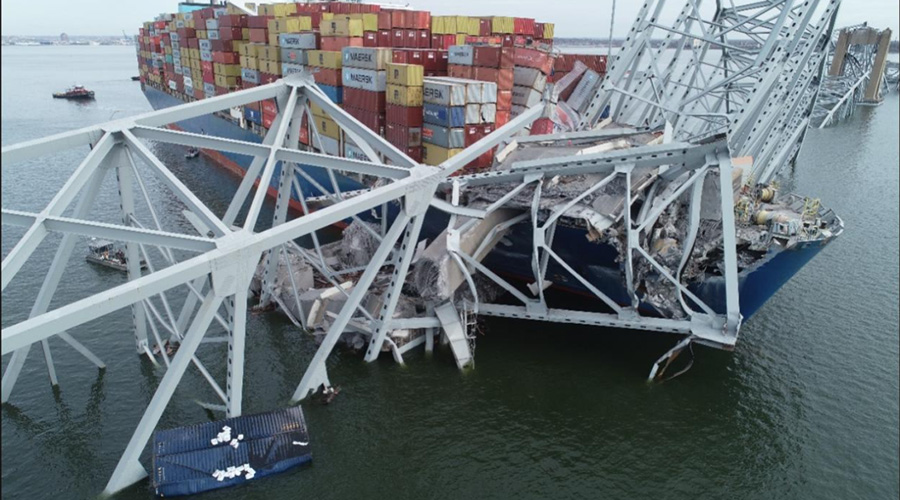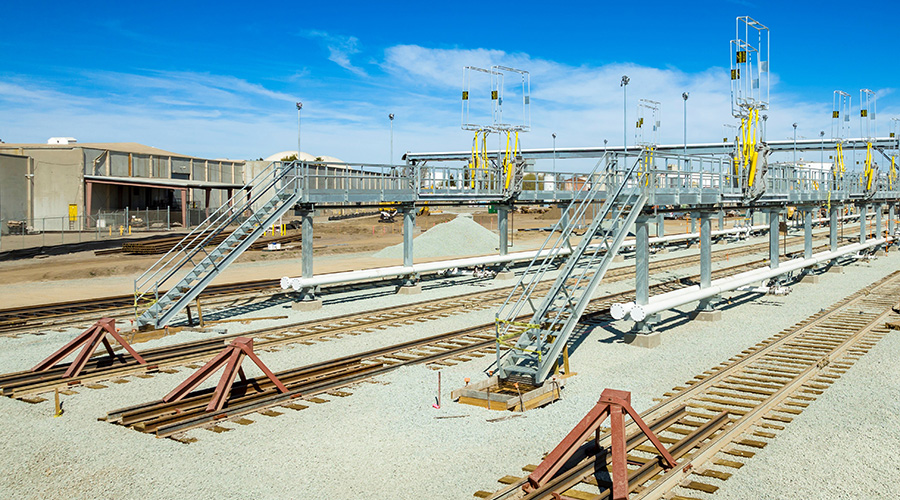House T&I panel reviews federal response to Key Bridge collapse
5/16/2024
By Julie Sneider, Senior Editor
Congress should wait for more information over the next several months before considering President Biden's request that the federal government fully fund construction of a new Francis Scott Key Bridge, Transportation and Infrastructure (T&I) Committee Chair Sam Graves (R-Mo.) said at a May 15 hearing.
Located at the Port of Baltimore, the bridge collapsed into the Patapsco River after being struck by the Singapore-flagged container ship Dali as it trying to make its way out of the harbor on March 26. The ship lost electrical power, propulsion and steering shortly before striking the bridge. After the Dali’s pilot notified the Maryland Transportation Authority that the ship lost power, the Maryland Transportation Authority quickly halted automobile traffic on the bridge before the collision. Eight construction workers were on the bridge at the time; one was able to run off the bridge prior to its collapse. Seven fell into the water; one was rescued but the other six died.
The National Transportation Safety Board (NTSB), the lead agency investigating the accident, released a preliminary report of its findings on May 14. On May 15, the T&I Committee held a hearing on the federal government's response to the bridge collapse.
Hours after the collapse, Biden announced that the federal government would pay to have the bridge rebuilt. Two days later, the Federal Highway Administration (FHWA) approved $60 million in quick-release funding from its Emergency Relief Program, which at the time represented about 5% of the initial $1.2 billion cost estimate to rebuild the structure. The quick-release dollars were used to help pay for emergency repairs to restore essential travel lost when the bridge collapsed, minimize damage or protect remaining facilities at the port.
 A National Transportation Safety Board investigator surveyed the wreckage of the bridge collapse. National Transportation Safety Board
A National Transportation Safety Board investigator surveyed the wreckage of the bridge collapse. National Transportation Safety BoardQuestions about an escalating price tag
In his opening statement, Graves said Congress has received Biden’s official request that it pay 100% of the rebuilding cost. But because the cost estimate has since increased to as much as $1.9 billion, Graves indicated Congress needs more information before it agrees to pick up the full reconstruction tab. Congress has six months left to decide the federal share before an automatic rate of 90% reimbursement kicks in, according to Graves.
“It is important that we have a firmer estimate before we take any further actions on the cost share,” he said.
Several T&I Committee members have visited the site to see the partially collapsed structure and motionless ship, with its bow pinned by what’s left of the bridge, Graves said. On May 13, demolition crews set off explosives to push broken bridge trusses away from the Dali.
At the hearing, T&I Committee members heard testimony from four people involved in the federal response to the accident: NTSB Chair Jennifer Homendy; FHWA Administrator Shailen Bhatt; Vice Adm. Peter Gautier, deputy commandant for operations, U.S. Coast Guard; and Maj. Gen. William Graham, deputy commanding general, civil and emergency operations, U.S. Army Corps of Engineers.
On the lookout for reimbursements
In his statement, Graves did not say whether he thought the federal government should fully cover the cost to rebuild the bridge. But several committee members — most of them Republicans — questioned whether and how the federal government could recoup its costs, such as through accident-related insurance reimbursements or bridge toll revenue.
“If the company that owned and operated the ship is found to be liable, we must make sure that the government actively works to recover any money it is owed,” Graves said. “That could help offset the bridge funding or be used to make the people and companies who rely on and work at the Baltimore Harbor whole.”
The port, which has remained closed since the accident, is slated to reopen by the end of May. The ship is owned by Grace Ocean Private Ltd. and managed by Synergy Marine Private Ltd.
FHWA Administrator Bhatt reiterated the Biden administration’s commitment to funding the reconstruction.
“The administration is asking Congress to join it in demonstrating a commitment to aid in recovery efforts by authorizing a 100% federal cost share for rebuilding the bridge, consistent with past catastrophic bridge collapses,” Bhatt said.
He said the FHWA is coordinating with other entities within the U.S. Department of Transportation; the Maryland Department of Transportation (MDOT), which includes the Maryland Transportation Authority and State Highway Administration; the city of Baltimore; U.S. Coast Guard; the U.S. Army Corps of Engineers; and others to mitigate supply chain impacts, manage traffic, reopen the port and ultimately reconstruct the bridge.
In response to questions, Bhatt acknowledged that before the collapse, the bridge was a state highway even though it was part of Interstate 695. As a result, the bridge received no federal funding prior to the accident. After the accident, the state of Maryland requested the bridge become part of I-695. U.S. Rep. Scott Perry (R-Pa.) noted that as a state bridge, it was a toll facility that collected about $56.8 million in revenue for the state in 2023.
“My questions center around payment for this [recovery],” Perry said. “I think it would be appropriate to consider reimbursing, through the tolls, the [federal] emergency fund before all of the money goes back to the state where the bridge resides.”
U.S. Rep. Brian Babin (R-Texas) asked Bhatt to explain the path forward for rebuilding the bridge and paying for it, adding that his “constituents aren’t interested in paying for this thing; in my view, the company or country responsible for the incident should be footing the bill, not the U.S. taxpayer.”
Bhatt said the preliminary schedule calls for the Maryland DOT to issue a request for proposals close to Memorial Day; a preferred design team would be selected in August; and construction on the new bridge would begin next year and run through 2028. In terms of payment, a system is being worked out for the federal government to recoup funds that are recovered via litigation activity or insurance payouts, Bhatt said.
U.S. Rep. Hank Johnson (D-Ga.) questioned the suggestion that taxpayers who live outside Maryland “resent” their tax dollars being used to replace a bridge that’s not located in their own state. He asked Bhatt to explain how the loss of the bridge affects interstate commerce.
“I think we’ve learned through the Port of Balitmore that the [U.S.] highway system is tied into the ports,” Bhatt said. “Baltimore is the third busiest port in the country. There are jobs being impacted, freight movements and neighborhoods are being impacted. So, this is not just an issue for Maryland, it’s an issue for the Northeast corridor and for our national economy.”
Bhatt also noted the USDOT has been monitoring the impact on major goods — such as coal, automobiles and farm equipment -- that typically move through the Baltimore port. Diverting that traffic to other ports and then back to Maryland is affecting costs along the supply chain, Bhatt added.
'What about East Palestine?'
Later in the hearing, U.S. Rep. Emilia Strong Sykes (D-Ohio) expressed disappointment that while the T&I Committee has organized a “very timely and necessary” hearing on the Key Bridge collapse, it hasn’t yet scheduled a hearing to discuss rail safety following the Feb. 3, 2023, derailment of a Norfolk Southern Railway train in East Palestine, Ohio. Since then, two other train derailments have occurred in Ohio and it was “by luck” that they were not as serious as what occurred in East Palestine, Sykes said.
“What about the people of Ohio and East Palestine who have been begging us to do something on rail safety?” she asked her fellow committee members. “It is very clear that the issue of train derailments is not going away. Turning a blind eye to this issue is clearly not the path that Congress should take.”
She called on the House Republican majority to act on the bipartisan rail safety bill introduced last year by Ohio Sens. Sherrod Brown (D) and J.D. Vance (R).
“The Rail Safety Act would implement effective measures that would keep our communities safe, hold railroad corporations accountable and ensure that no American living close to our 140,000 miles of railroad track has to worry about the threat of a toxic train derailment in their backyard,” Sykes said.
Following her remarks, U.S. Rep. Eric Burlison (R-Mo.) asked the NTSB’s Homendy if it was accurate to say that rail is the safest mode of transportation for moving goods and services.
Homendy responded: “For transportation, over 40,000 people are dying on the nation’s roads. So as far as transporting goods and people, rail is incredibly safe. It doesn’t mean that a tragedy doesn’t occur.”
Burlison followed up: “So, it would be dangerous if we started moving activity away from rail because of these events?”
Homendy said: “I’d like more things to go on rail.”
Burlison then noted that while the East Palestine derailment led to environmental hazards, no one died in the accident.
“It’s important to recognize the numbers,” he said.


